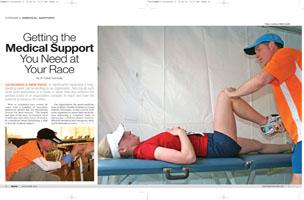
 |
| Photos courtesy of Metro Health |
Launching a new race, or significantly expanding a long-standing event, can be exciting for an organization. Not only do such races build awareness of a cause or issue, they also enhance the positive brand of an organization, broaden its reach and have the potential to enhance its coffers.
New or expanded race events do come with a number of less-than-glamorous details that are nonetheless critical for their success. The length and time of the race, its location, level of difficulty and other issues all need to be considered when developing a plan to provide medical support.
Our organization, the sports medicine team at Metro Health Hospital in Grand Rapids, Michigan, works closely with event organizers to assess their needs before deploying a volunteer team of physicians, certified athletic trainers, physical therapists and emergency medical technicians at a race. Our group will often trade on-course advertising or sponsorship of the event for our services, which generate name recognition – and often more patients – for our practices. We also offer financial sponsorships in some instances.
 We provide medical support for professional, collegiate and high school teams in the greater Grand Rapids community throughout the year. Additionally, we also volunteer our services to support approximately 25 races and community events each year – from small 5K events to the internationally acclaimed Fifth Third River Bank Run each May, which draws more than 20,000 walkers and runners.
We provide medical support for professional, collegiate and high school teams in the greater Grand Rapids community throughout the year. Additionally, we also volunteer our services to support approximately 25 races and community events each year – from small 5K events to the internationally acclaimed Fifth Third River Bank Run each May, which draws more than 20,000 walkers and runners.
First Things First
When our team is approached to provide medical support for a new race, we meet with the race director to assess the course before we develop a plan. We prefer starting the process at least six months in advance, particularly for larger events.
We begin by asking initial questions that help us gauge the scope of needs. These include:
• What is the course like? Is it hilly, flat or a mix? The tougher the course, the greater the likelihood medical support will be needed.
 |
| Photo courtesy of Metro Health |
• How difficult is the course? We have seen an increase in “mud runs” over the past few years. As the name implies, these events have participants running through mud, jumping over walls in an almost boot-camp style of racing that generate more severe injuries, such as broken bones.
• How long is the race? For example, 5Ks generally require a smaller medical support team than do marathons or triathlons. However, 5Ks in the spring and summer can attract less-than-practiced runners who may over-extend themselves and require medical extension.
• How many participants do you expect? Again, the more runners there are, the more medical supplies and staff you will need to have on hand.
• What time of year will the race be held? Each season has both benefits and challenges.
• Where is the course located? It is in town or out of town? Will streets need to be closed? What other resources are nearby in case of emergency?
 These and other variables – weather conditions, experience of the runners, etc. – must all be taken into consideration when developing the plan for medical support. If your event is a 5K that expects to draw 500 participants, you should consider three medical personnel and an EMS unit. For the Metro Health Grand Rapids Marathon that draws 5,000 runners, we use up to 100 medical personnel.
These and other variables – weather conditions, experience of the runners, etc. – must all be taken into consideration when developing the plan for medical support. If your event is a 5K that expects to draw 500 participants, you should consider three medical personnel and an EMS unit. For the Metro Health Grand Rapids Marathon that draws 5,000 runners, we use up to 100 medical personnel.
On-Site Medical Supplies
From a medical perspective, one of the main keys to hosting a successful race is having the supplies you need when and where you need them. Our team offers to bring all of the medical supplies, but always asks the race to supply the tent. What size will you need? A good rule of thumb to follow is this:
• A 5K race that will attracts 500 people should have a 10 x 10 tent
• A marathon may require a 20 x 40 tent—at our 25K race, we use a 20 x 80 due to the length and size of the event
Tent location is key. We recommend placing it just after the finish line so that runners coming off the race can go directly to the tent if necessary. Additionally, it’s a good idea to put it slightly off to the side so that you don’t interfere with spectators or others gathered at the end of the race.
Our sports medicine team stocks the tent with the supplies we know we will need, such as bandages, skin lube, etc. It works best to pack supplies in large plastic tubs or medical bags that are labeled for convenience. For example, we will have a sprain-and-strain tub, a blister kit, cuts-and-bruises bag, etc. Don’t forget a cooler stocked with ice and ice bags.
 |
| Photo courtesy of Metro Health |
Other supplies are necessary, but will require a doctor to give them out. These include Motrin or Tylenol, an inhaler, Ambu bag for delivering oxygen and related items. In conjunction with the EMS team, it is a good idea to have a defibrillator, crash cart, IVs and other related items that create a mini-MASH unit in the case of bigger medical emergencies.
We also recommend having aid stations spaced throughout the course. It’s important to work with the race director to understand the route, which often has runners going out and then coming back along the same lines – so aid stations can do double duty. For short races, such as 5Ks, we do not station people along the route. For a half or full marathon, we space aid stations approximately 1.5 miles apart. This gives us the coverage we need and the appropriate eyes on the runners.
Make sure water is available. Each of the aid stations along the route should be equipped to hand out cups of water and sports drinks to runners. It is also critical to have water available at the end of the race. If the race is held during the very hot months of summer, consider having a hose or blow-up pool available after the finish line to cool down runners quickly.
Whether the race is long or short, consider having bike medics patrol the course to keep an eye on runners or reach someone who needs help between aid stations. Allocate more of your resources toward the end of the race. In longer races, that’s where more problems are likely to occur.
Race Day Communications
Communication on race day is one of the final big considerations you will need to make. Key areas include:
• Identifying a medical director. This physician should be in communication with the race director, local law enforcement, aid stations and medical volunteers. If the race requires on course aid stations, each station should have its own captain, too.
• Designating a spokesperson. In the event of media inquiries about an injured runner or race incident, the medical and race directors should be in contact to coordinate what type of information will be released and provide that information to the spokesperson. (Remember to keep HIPAA in mind at all times.) All information should be funneled through the spokesperson, who may be the medical director or the race director or a third party, to ensure that misinformation is not being shared and that the event is speaking with a single voice.
• Sharing cell phone numbers. This is one of the best ways to keep in touch throughout the race. We put the name and cell number of the medical director and key members of the team in each tub in the medical tent and at each aid station. You can also list key cell phone numbers on the back of race identification badges worn by the medical team.
• Developing a written emergency action plan. Consider the most likely scenarios – what to do in the event of lightning or a storm, what happens if a runner is sick or injured and requires transport to a hospital – and have a strategy for dealing with them.
Any time you get a group of people together for a dedicated activity such as a race, something is likely to happen. Whether it’s a minor slip-and-fall incident or something major such as a heart attack, it is important to be prepared to ensure a successful event.

